|
Interview with Lynton V Harris of Sudden Impact
Sunday, March 11, 2007
It seems at the very least a risky business model to scare your customers off, yet The Sudden Impact! Entertainment Company have made it their bread and butter. | 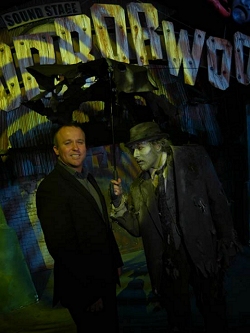
| | Lynton V Harris of The Sudden Impact! Entertainment Company | Lynton V Harris is the founder, Chairman and CEO, and Sudden Impact! have made it their mission to move the idea of interactive walk through shows away from simply achieving the flimsy pretext of being Halloween attractions to fitting the far more profitable and accessible format of being more general forms of entertainment playing on the universal emotion of fear. An Australian, Lynton V Harris was a surfer cum Marketing Director for eight regional radio stations. With a dream of moving to America and chasing fame in Hollywood, he visited New York New York where an advert in the entertainment trade magazine Variety caught his eye. It was for the Radio City Christmas Show, a performance that went on to take USD32m (GBP18m) in a matter of months. Inspired by the concept versus takings, Harris pondered whether the similar niche of Halloween could perhaps be exploited. Back home in Sydney, Harris quit his job and focused all efforts on writing a Halloween musical to be shown in the enormous 13,000-seat Sydney Entertainment Center. Six-or-so months later, despite losing thousands, the show was a success of sorts - Harris wrote the experimental show mainly to get his foot on the live entertainment ladder, using a video of the show as a multimedia portfolio to take with him to America. Harris bit the bullet in February 1993, when he packed up his life and moved to New York. It took three years before Harris' idea came to life in earnest, as the 40,000 square-foot Madison Square Garden was transformed into a vast interactive Halloween show, Madison SCARE Garden. With live acting talent and a labyrinth of dark sets, Madison SCARE Garden became an annual Halloween institution scaring over quarter of a million people in just four seasons. But Lynton still wasn't happy. Why settle for just 250,000 over the space of four holiday seasons when there was no reason why these live walk through shows couldn't become year-round, as a broader entertainment opportunity? Putting a three-year Harvard education in Owner President Management to practice, Harris began selling the idea of the walk through shows to Hollywood movie theme park studios like Paramount and Universal. After 'testing' The Mummy LIVE as part of Madison SCARE Garden, and to prove how the concept had universal appeal and didn't have to fit within the Halloween agenda, Sudden Impact! created The Mummy Returns LIVE! and toured it to Dreamworld Australia, in their June/July winter vacation period. It was a smash hit success, and Australian audiences were thrilled (and scared) to bits. Universal Studios followed suit, and opened The Mummy Returns Live, a lavish walk through with nine massive crypts themed to the two Mummy films. Since Madison SCARE Garden, Sudden Impact! attractions have opened in the UK, Singapore, Hong Kong, Shanghai, Amsterdam, Las Vegas and a return visit to Dreamworld on Australia's Gold Coast with Lara Croft: Tomb Raider LIVE!, for the high profile Christamas/Summer vacation season. Booked for a month, the show was extended for a further three months after breaking Dreamworld's attendance records. This was Dreamworld's most popular show for a decade, proving that Halloween was an unnecessary constriction when it came to scare-mongering. Europe's first encounter with Harris' dark side was in 2002 when Thorpe Park introduced Fright Nights. The cornerstones of these events were two haunted walk through mazes - The Freezer and Freakshow 3D. While both of these mazes scared ticket holders into submission, neither resorted to blood and gore, and neither relied on actors simply jumping from darkened corners screaming 'boo!'. Elsewhere, in Staffordshire, the reportedly haunted Towers themselves were the slightly sinister setting for Terror of the Towers, part of Alton Towers' short-lived Halloween Spooktacular. Tussauds' love affair with the dark and macabre snowballed from this, and itself went to show how the idea of scaring guests wasn't limited to dark and autumnal evenings with Warwick Castle and Madame Tussauds both operating Sudden Impact! mazes throughout the year, both in unique and challenging locations. Warwick Ghosts Alive! in fact introduced the 'theatrical play' style of scare show that is a fully scripted and choreographed, interactive short play. We were afforded the chance to speak to the Sudden Impact! dark lord himself, Lynton V Harris, who told us about the art of scaring people. Coaster Kingdom: How exactly did you get into scare mongering? Was it a passion that slowly evolved, or did you identify a niche that needed to be exploited? | 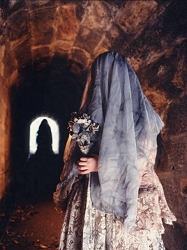
| | Blood is often surplus to requirements | Lynton V Harris: "I first created a show in New York called Madison Scare Garden, which played at Madison Square Garden from 1996 to 1999. It was purely an 'entertainment' business play, modelled around the success of the Radio City Christmas Spectacular. I had no passion or peculiar interest in horror, or scary entertainment per se." CK: So, how competitive is the haunted house market, and how do you make sure that you stay one step ahead of the competition? LVH: "I believe that we have become the best producers of live, scary entertainment in the world because we do not subscribe to the 'haunted house' market. Instead, we use 'scare' as the entertainment device, and theme, like drama, romance, action, musical etc. Like Cirque Du Soleil's vision of the circus, we have strived to reinvent the 'haunted house' as a show." CK: Are there any particular qualities make an actor good at their job? Is it down to simple psychology, blatant ferocity, or is it more complicated than that? LVH: "Our training program, "Lynton V Harris' Scare School", which is approximately 40 hours, takes a whole range of different actors and performers, and trains them in the art of scare. There are many qualities that we look for, depending on the role. As an example, we are known to hire female dancers for out 3D experiences because of their great flexibility and movement skills. We call our actors 'reaction engineers'." CK: The British are renowned for their apathy towards Halloween. Was this something you are consciously aware of when you worked on attractions like The Freezer, Freakshow 3D and Terror of the Towers, did you have to tackle this indifference, or do your attractions sidestep the problem by being less about Halloween and more about just making people run for their lives? LVH: "All of the attractions that you mentioned could be anywhere at anytime, and do not use Halloween themes for their success. Again, we take the view that we are creating entertainment, so we are focused on the delivery, and the reaction of the audience. The Freezer for instance is such a cool attraction (with the right cast!), and looks nothing like a haunted house per se, but is probably the scariest experience that we have created. It works everywhere." CK: What are the biggest obstacles and challenges you face as a scaremonger? Are there any consistent constraints you encounter from project-to-project? LVH: "Finding the perfect cast! Apathy from some clients who feel that anybody can do it. When we have set up an attraction or experience for someone, and then leave, they are quite often managed with less care than what we would expect, so quality control is our greatest challenge." CK: What timescale does the production of a maze or haunted house have? How many people are involved with producing the attraction, and how involved do you get as CEO? LVH: "Our shows range from 100 square feet, to 75,000 square feet, so production of our experiences depends on size. I am involved as the Creative Director on all our projects, and as CEO for the deal making. My business partner, Edward Michitsch, heads up the physical production of the shows." CK: How involved do your clients get? How does it vary from project to project? LVH: "It varies, although we are well regarded and trusted due to our worldwide experience and reputation." CK: What exactly is involved producing a haunted house? Presumably there are rehearsals; what is involved in these, and what kind of things are normally changed before the maze opens? LVH: "We do not refer to our attractions and experiences as a 'haunted house'. They are theatrical shows that require all of the same disciplines that any live stage show requires, and then some… the actors are working in the dark, and up extremely close to a moving audience! It's a recipe for disaster if not taken seriously." CK: What makes a good maze? Is it as simple as making people scream or are there other qualities that are just as important? LVH: "It should have a great theme, strong entry, interesting design, and great scare points. We detest the cheesy, corny, or cliché! In fact laughter [at the reactions] is probably our biggest emotional response." CK: Do attractions designed not to make people scream represent a bigger challenge in terms of design due to the obvious limitations this creates in terms of emotions? | 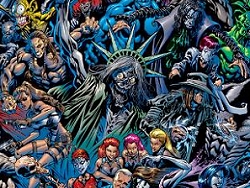
| | Work from the studios of Sudden Impact! Nightmares 2005
Philadelphia
Monsters Alive
Universal Studios California
Madison Scare Garden
New York
The Fright House
Washington DC
The Mummy Live!
New York
Van Helsing Experience Live!
New York & Philadelphia
Chamber of Horrors Live!
Madame Tussauds New York | Warwick Ghosts Alive!
Warwick Castle
Serial Killers Live!
Madame Tussauds London
Scream!
Amsterdam | Mummy Returns Live!
Hong Kong, Singapore, Australia
The Scorpion King Live!
Hong Kong
Lara Croft Tomb Raider Live!
Australia | LVH: "No - It's all entertainment. The degrees of emotion are all by relevant design. Our design criteria is actually threefold: make it cool to look at... make it entertaining... make it scary. That way, you are not relying on just one emotion for a result." CK: What do you think the attraction is for theme parks to add one of your attractions? How do you go about clinching that deal, and is it a difficult job selling the virtues of an interactive walkthrough? LVH: "We have been producing scary shows and attractions for ten years, worldwide. It is a basic human emotion, and has no language barriers. We have so much great evidence of success these days, that it is a much easier story to tell, and sell. "Further, theme parks cannot afford the multi-million dollar rides every single year. We have proven that we can offer an experience that gets audience reactions equal to thrill rides, at a much, much, lower capital cost, but with a higher operating cost. Our worldwide resume also proves that we have tapped into a universal form of entertainment." CK: Has the Internet helped The Sudden Impact Entertainment Company sell the idea of haunted houses abroad, or are trade shows still pivotal to your success? LVH: "The internet is cool as a tool to show streaming video, and high quality presentations to anyone anywhere. Trade shows are still very important, depending on who you are pitching to." CK: What to you has been your greatest achievement? Can we look forward to bigger and better in the future? LVH: "The sheer gall of Madison SCARE Garden in New York was an awesome experience. In Europe, I love our show at Warwick Castle, Warwick Ghosts Alive! It still gets people everyday, and we have now scared over 250,000 people in that show alone! We also just finished shooting a television series called 'Scare School'" CK: Many of your attractions are permanent (Serial Killers: Live, Ghosts Alive!, The Mummy LIVE!), how far-reaching is your involvement once they have opened? Is acting talent within your jurisdiction, or do the parks handle elements like this? LVH: "We mandate through contract to manage our shows that involve the movie studios, The Mummy LIVE! etc, but still manage Warwick Ghosts Alive! at Warwick Castle which has been consistently rated the best in the Tussauds Group. I like to think that it is because we manage the cast with our Assistant Director on-site." CK: Do you have continued involvement with annual attractions like Freezer (now Asylum), or do you hand over intellectual rights to the park after the first year? LVH: "They cannot re-create what we built without permission, however they can use the intellectual property of what we built under license. It can be troubling to hear of certain changes and methods to The Freezer [now Asylum] for example, which could ultimately damage our reputation even though we are no longer involved." CK: How do budgets for mazes vary? Is money a limiting factor, and how easy is it to do a maze on a budget? LVH: "Every production has a budget. Size and scope, temporary or permanent, inside or outside... there are many factors to consider. Our attractions start at about USD 250,000, and range up to USD 2m. We are planning to design a touring arena show at around USD 5m" CK: What do you see for the future these attractions? Are events like Halloween Horror Nights (Universal Studios) getting bigger indicative of the haunted house industry in general? LVH: "Frankly we see the growth to be outside of Halloween, which is too limiting, and culturally irrelevant in most of the world outside North America. Since 9/11, when we had to cancel and postpone a planned production in Washington DC, we have only done Halloween if someone calls us. In fact, our most successful shows have been in the summer and non-Halloween seasons." | 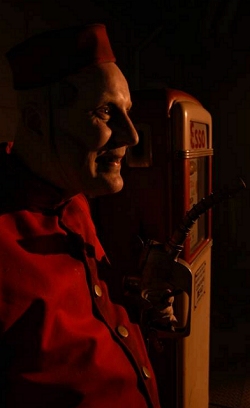
| |  We see ourselves leveraging into television and film We see ourselves leveraging into television and film 
| CK: Can you see the Sudden Impact Entertainment Company branching out from haunted houses in the future into other markets, or do you deliberately choose to focus on what you know best? LVH: "We see ourselves leveraging into television and film. We have produced different themes of entertainment though we have become known for being the world's best at scaring audiences." CK: Do you get a chance to try other companies' and parks' haunted houses in Europe and further a field? What events/attractions have impressed you? LVH: "Knott's Scary Farm and Universal Studios are all that have impressed me, although I disagree with their cattle call throughput. "We limit our throughput to 750 an hour to maintain quality." CK: What is the best aspect of your job? Have any moments stood out as epitomising why you love your job? LVH: "Watching an audience come out and laughing, exchanging the experience with each other. Pure entertainment. It's a privilege to create that moment for them. I also love people leaving before the experience has finished. That always cracks me up, that even though they know it's make believe, we are controlling the environment, and their reaction to it, by great acting! I have heard great stories where kids go home and try and scare their parents!" CK: What would you have changed on any of your attractions given the chance? LVH: "I always strive to make them better, with more elaborate sets and costumes, and use of the 360 degrees that surrounds the audience. Multi-sensory, multi-dimensional and fully immersive. Need better technology, and bigger budgets!" Labels: Interview
Life of Bryan: An interview with Colin Bryan
Sunday, March 11, 2007
Colin Bryan was last interviewed by Coaster Kingdom eighteen months ago. Since then, he's seen the opening of Maurer Sohne's 'X-Car' coaster G-Force, as well as enjoyed his fortieth year as manager of the park, and put the plans for Drayton Manor's accommodation developments into full swing. | 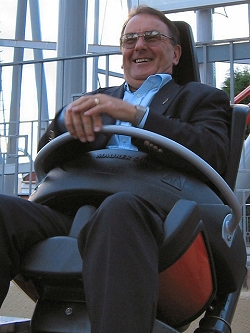
| | Colin Bryan, Managing Director and Family Owner of Drayton Manor Park | We catch up with Colin. Coaster Kingdom: How has your fortieth year been overall? Colin Bryan: "Very hectic! I've found myself very busy with G-Force for one, as well as our VE day celebrations events over the summer. They went very well, however the turnout was a little lower than expected, but the event, especially the spitfire fly past was very good." CK: Onto G-Force... why did the park choose the X-Car design? CB: "The restraint system caught our attention, the 'Big Boy' seats [capable of holding passengers of larger body mass] and the design [that allows guests to be suspended upside down safely and comfortably]. These are very different from usual over the shoulder restraints. "I believe the ability to safely and comfortably restrain a wider variety of guests is important as our culture changes, i.e., The enjoyment of our larger guests. "Lastly, it would efficiently fit into the space left available." CK: And you're impressed with G-Force overall? CB: "I am impressed with the coaster overall, but not with its faults. Something as simple as getting a train around the track shouldn't be difficult [G-Force has previously stalled]. One of the requirements with the manufacturer was quietness... where as in reality the quieter wheels skid along the track. Of course, there were bound to be teething problems with a world's first coaster featuring an upside down lift hill!" CK: How has attendance worked out? CB: "Attendance figures have increased since G-Force opened. We are up 7% on this time last year. "Opening a ride mid-way through the season has its advantages - the opening buzz usually extends into the following season, and people may have already ridden the likes of Rita - Queen of Speed at Alton Towers which was also new this year." CK: G-Force is heading in the thrill ride direction. But Drayton Manor intends to stay a family park? CB: "It is important for us to provide a broad spectrum of rides and attractions for all ages. G-Force is a youth ride, but the 1.3m height restriction helps its family appeal." CK: Do you consider the investment in these big boy seats to be important? CB: "Yes, and I believe the way people and the industry is changing, we'll see more in the future." CK: What are you particularly proud of within the park and the business? CB: "Undoubtedly the staff. Without them, it wouldn't matter how good or bad the rest of the park was. We have 197 full time staff, and 250 part time, with around 600 people through the books every year. Some of them are third generation in terms of families employed at the park, which is nice to know as a 'family theme park'." CK: What other parks have you been particularly impressed with? | 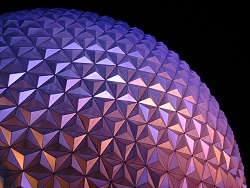
| | Florida - a poignant place for the Bryan family | CB: "Europa Park, undoubtedly. I've visited four times now." CK: And your favourite ride? CB: "Dinosaur at Disney's Animal Kingdom, although I'm also fond of Indiana Jones Adventure at Disneyland. They don't give my back too much trouble!" CK: So theme parks and the industry are a big part of your life? CB: "Oh yes. And both my sons met their wives at Drayton Manor and honeymooned in Orlando, Florida." CK: What are the principal advantages of being family run? CB: "Control! If there's a decision to be made, it can be made straight away, whereas places like Alton Towers have to take it to the board of directors, and the shareholders. There is also constancy for the park. We're without a new manager every year or two." CK: Why did you choose to change the admissions policy at the park? CB: "The new pay one price system has reduced theft dramatically, which was becoming an increasing problem. The old system was easy to cheat. Even though there are still teenagers who climb over fences, at least they can be ejected from the park now if they don't have a valid ticket." CK: How do you feel about Fastrack or Fast Pass systems? CB: "We don't plan to invest in any, although Apocalypse's queuing system was designed with it in mind." CK: Without council restriction, what would be the first thing you'd invest in? CB: "A wooden coaster, definitely. The enthusiasts want wooden roller coasters, it's original and missing from most UK parks. It's the one, definitely." CK: And what planned projects can we look forward to? CB: "I'm very excited about the upcoming 4D Cinema, as well as the hotel and waterpark expansion over the next few years. I have been rather occupied by endless talks with the council about the latter for several years now. Alton Towers got the permission for Splash Landings and Cariba Creek in a matter of months." CK: A lot of attractions thrive or fail thanks to competition. You've been here for 40 years now - what's the main competition these days? CB: "Retail, but particularly Sunday shopping. It's simply a much bigger threat than any other theme park or tourist attraction out there." CK: Have you ever considering catering guests with a cocktail of the two? CB: "Yes, but as I've learnt from other smaller parks, retail and amusement rides don't mix. It nearly bankrupted Lightwater Valley several years ago, for example. It's a completely different day out." CK: Do you think the amusement industry is well represented in the UK? CB: "No, and I'd like a level playing field with Europe in terms of tax and operation. In France, Germany and Spain, parks pay around 6% tax instead of 17-19%, as they bring an economic boost. [At the time of this interview, Drayton Manor could afford GBP 200,000 in re-investment if similar policies were in force]. Out of all of our takings, only around 6% is profit. For such a major employer, theme parks and the industry deserve a much stronger representation from the UK government." CK: On a lighter note, do you talk shop at family events? CB: "I am a qualified catering manager by trade, at 15 I was helping out on parks, as well as operating rides. At 17 I was a full time employee at the park, before my catering degree. "I do talk shop at family events - but it's much more a way of life than an occupation." An 'inland pleasure resort' After 50 years in the business, Drayton Manor have decided to put themselves onto the short break market, following Alton Towers and Pleasure Beach Blackpool, as well as popular European hotspots such as Disneyland Resort Paris and PortAventura. | 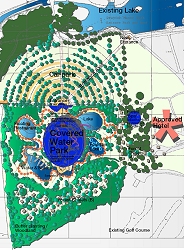
| | The Drayton Manor masterplan | Opening in 2008, the new plans spell the biggest investment by the park to date, and hope not only to bring two hundred thousand new visitors each year, as well as 180 new jobs, but also that locals will be attracted to the waterpark during quieter times to ensure frequent revenue. It will be named 'Stormalong Bay', and be of a similar stature to Cariba Creek, opened at Alton Towers in 2003. Currently, the park only have a popular but limited caravan and camping park. Conferences and banqueting have already proved popular at the park for a number of years. The new and extended plan will compromise of an £8 million 86-bedroom 202-bed hotel, an estate of around 40 log cabins, three banqueting rooms, cinema, woodland spa, floating restaurant, improved access and car parking, as well as the plantation of around 3800 new trees to improve the local environment. The short break market is now a huge earner. Drayton Manor have even more of an advantage than rival Alton Towers in regards to central location - Tamworth is in easy reach of three major nearby motorways, the park is less than ten minutes from the M6 Toll and around half an hour from Central Birmingham and Birmingham International Airport is a similarly sharp journey. 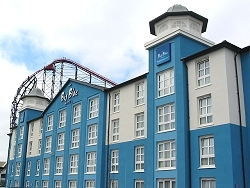 | 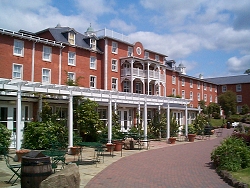 | | While Pleasure Beach Blackpool have the Big Blue Hotel (left), and Alton Towers have the Alton Towers Hotel (right) and Caribe Creak, Drayton Manor side-step the competition by offering a Centre Parks-style resort. | |
| In 2005, Pleasure Beach Blackpool added a new wing to their Big Blue Hotel, offering a range of accommodation from pricey club suites to spacious family rooms, and Drayton Manor can offer much more room for expansion within its woodlands and grounds. Recently, it was announced Alton Towers would continue it's recently adapted 'resort' mantra, with several schemes to spruce up and expand the park. As well as the inevitable third hotel, 'Project Dolphin' will offer a series of 'once in a lifetime' experiences for guests - Rita, was declared the park's last roller coaster for several seasons, whereas Drayton Manor may continue to struggle to keep up with the corporate investment offered at Alton, especially since their purchase by Dubai International Capital (DIC). But as the 'brand' park near Stoke continues to grow in price as well as stature, its South Staffordshire neighbour will doubtlessly remain the affordable alternative, which has always given it an edge of popularity over what is easily one of the most value debatable parks in Europe. In fact, despite its tax woes, Drayton Manor has always remained a more budgetary day out, and one that's never sat on its laurels - over the past decade or so, we've seen the introduction of a world's first freefall ride, a new generation flume, a fairly sizable investment in a family boat ride, all having kicked off with Shockwave in 1994. | 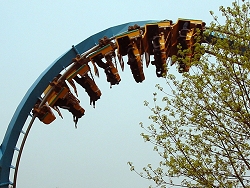
| | Rides like Shockwave go to show that the park isn't shy when it comes to spending money | It's also worth noting that the park has one very unique and long established advantage in becoming a roaring success in the future - the largely ignored zoo establishment. Where as Alton Towers is largely about going very fast lots, Drayton is also respectful of its heritage, offering museums, and therefore presents more leisurely pursuits. Chessington are also considering a resort option, and have developed a similar 'master plan'. Inviting a younger family audience, they still have the advantage of animal attractions (on which the hotel will reputedly take its base) and a fairly pleasant suburban area. However, also under the thumb of Tussauds, it's to be expected costs per stay will hover a bit higher than at Drayton Manor, which from a guest perspective, does well under its family and more down to earth ownership. Labels: Interview
KMG: King of the kermis
Sunday, March 11, 2007
Sometimes you'll put something on the back burner to simmer, then, before you know it, it'll be boiling over. KMG have been bubbling away since 1989, but in earnest, it wasn't until about ten years later when they boiled over with the success of the Afterburner. You'll soon learn how their expertise pre-dates the Afterburner, but ever since, the Dutch manufacturer has quickly become synonymous with manufacturing easy-to-build, well presented, good value, showmen-friendly rides. | 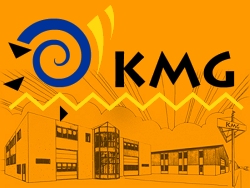
| | KMG: Best known for their popular Afterburner ride. Image: KMG | Despite being a small company, KMG manage to fabricate 15 rides every year, and are a one of a kind in that they build rides that appeal not only to the ever-particular German showman, but to British showmen, European showmen, American showmen and even theme parks. Honestly, that is a claim precious few manufacturers have bragging rights to. Their best-known rides include the Afterburner, which is now available in five different versions, the Tango, which is a spectacular alternative to Mondial's Top Scan, the Move It (available in three different sizes) as well as their popular line in Miamis, Discovery (similar to a Top Spin) and Speed, their take on Fabbri's Booster ride. Despite offering a diverse range of rides, all share at least one similarity; they are designed by showmen for showmen. With KMG's heritage being built around the Kroon family, who themselves tour rides, every element that is important to the showman touring the ride has been encompassed into the design of the ride. Having just launched the XXL, one of the largest swing rides in the world, curiosity got the better of us, so we spoke to Bas Derkink from the company. | 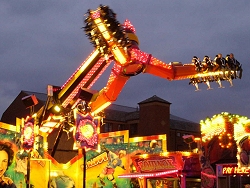
| | One of Bas' first jobs was calculating kinetics for this ride, Tango. | Bas joined KMG in 1999, full time from 2000, his expertise spanning from a mechanical engineering degree to work experience at KMG where he worked on calculating kinetics for their new-at-the-time ride, Tango. Since then, Bas' role has grown to include responsibility for electrical design, programming controllers for their rides, dealing with service enquiries from customers as well as bridging the gap between R&D and fabrication. It's a varied role with Bas found somewhere between the office desk and the factory floor, but somehow, he spared the time to answer some questions. Coaster Kingdom: Tell us a bit about the history of KMG. Was there life before the Afterburner? Bas Derkink (KMG): "KMG stands for Kermis Machinebouw Gaasendam, which in English means 'Gaasendam Fair Attraction Construction Company'. "Gaasendam is the surname of founder Isje Kroon's wife. Isje started KMG about 17 years ago when he built a backflash for a Dutch showman's Huss Breakdance. Isje has always been into building things himself and travelling all over Europe with self-built and fabricated rides like a Schwarzkopf Blitzer. His father and uncles were also into the business that built Ferris Wheels. | 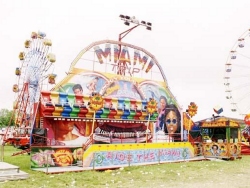
| | The Tropical Trip, the design of which was stolen by several manufacturers. Image: Miami Madness | "When he completed the backflash for the Breakdance (which was a unique design by building up the backflash and floor together), he got more jobs to build for others and to build his first Miami ride. "He got several engineers which drew and calculated the ride for strength. The ride was very popular from the beginning but as Isje was just alone with one or two employees, he could only build three Miamis a year. "Also due to this and some other struggles, he did not protect his copyright and design so one of the engineers went away with the drawings. What followed was a lot of Miamis being built in the UK; not all too good. Until now about 28 Miamis have been built by KMG. "The next ride was the Discovery, a huge ride (45 tons) on only one semi-trailer and being set up in an hour and a half! There were five of these rides built. More employees were hired and new rides were developed. "First there was the Move-It 32, the only one built. The ride was unique in its kind and on three semi-trailers. Again, the ride can be built up in 2 hours if needed due to a very smart build up system. "This smart building up of rides has always been the keyword for KMG rides. And during this period smaller versions of the Move-It were developed (18-person and 24-person version; later built under licence by Tivoli for the USA market). "In 1998 the first new swing was developed; up to then all swing rides had three properties which were ignored by KMG. All the swings were driven by a wheel on the bottom of the ride. Due to this, all rides of this kind were enclosed (causing many people to get sick easily). Also due to the drive wheel, the swing could not go much higher than 90-degrees from vertical. "From that moment on, KMG developed its first Afterburner ride with three sensational improvements: The ride seats had a very open structure with suspended seats, with dangling feet. This was possible due to driving the swing from the top; the swings pivot point. "This was also one of the first rides with the use of frequency inverters. With this, AC motor control was never so easy, and made it possible to drive a swing with much less power. So the motors were smaller and the swing could be higher. 120-degrees to be precise. "The Afterburner turned out to be a success, which we did not expect. The 24-person model on two semi-trailers was a huge success and after building 30 rides, the market dropped and we found out that the ride was just too expensive for a lot of people. "After Fabbri from Italy said they could build their Afterburner 24 ride on only one trailer (which turned out to be a disillusion for many showman who bought the ride with this belief), KMG decided to show Fabbri how to build an Afterburner ride on one transport. "The Freak Out was again a success, and just before the dollar crashed, KMG had sold already twelve models of this 16-person ride on the Gibtown exhibition in Florida. "Up to now more than 73 Afterburner type ride have been build either in a 16, 20, 24 or 32-person version. "In the later years, KMG has also developed some other spectacular rides like the Experience (7 rides), Tango (6 rides), Waltzer (1 ride), X-factory (3 rides) and the easy version of Fabbri's Booster ride; the Speed (12 rides)" CK: So, what qualities do you think make KMG rides so popular? KMG: "Very easy to build up and move from one fair to another. We always try to eliminate loose parts. A showman only needs to move part one time; from the storage to its final position in the ride. "When possible we do not want to take parts apart and have everything connected together. The founder of KMG Isje and his son Albert were always travelling showmen and know how things need to be working on a fair." CK: Many of your rides come in different sizes. Is this by design, or do you only work on different variations if showmen express an interest in smaller/larger versions of the ride? KMG: "Usually we design a ride according to what we think is the best combination between showmens' wishes and the ride which is easy to build up. In the first place we must believe in the design, otherwise it's not gonna work. After the ride is finished, there might be several factors to change the ride size. "Sometimes the ride is sold to a static location and build-up time is not an issue. The main design of our rides is constructing the system to fold the ride onto a small transport. When the ride is due to operate in a theme park, there is more space to build a larger construction. "Therefore we designed a larger brother of our Afterburner 24 ride, the Afterburner 32 (Vortex at Thorpe Park). While the market of rides was shrinking in 2001, Fabbri announced their copy of the Afterburner ride as a 24-person, 1-transport model. "When their ride was finished, they just copied our ride without reducing the number of loads, and we discovered that many showmen were requesting an Afterburner ride on only one lorry. "We decided to show Fabbri how a one-transport Afterburner should look like. We had to decrease the number of seats to 16 to make it possible, but this was not a problem for the showmen. The ride was cheaper, easier and still the same height as the Afterburner ride." CK: How big a part do theme parks play when you design rides? Were rides like Afterburner 32 designed specifically for theme parks, and would you ever design a ride for a park before you design it for showmen? KMG: "Our roots are in the transportable rides. We get the most satisfaction from designing the transport systems of the rides. "In our eyes, everybody can design a ride for a theme park if space, weight and size of parts do not matter. The main challenge is to create a large ride with a small transport. "Therefore we will only make a theme park model after a transportable, and not the other way around." CK: Can you explain a bit about KMG's relationship with Chance Rides? Do they simply sell your rides in America, or do they fabricate them from your plans too? Why is this? KMG: "The relationship started to help them with giving them work since the business for USA factories was slow. We helped by designing a ride for them, they helped us by giving us an entrance into the theme park world. "The first ride was built by us (Vortex) and after the first one, Chance rides took over the production of the Revolution rides. We even designed a 20-person version of the Afterburner ride, which is also being built by Chance Rides Manufacturing." CK: What role do trade shows, magazines and the internet play in advertising KMG? What proportion of rides are sold as a result of direct marketing and how many are sold simply through word of mouth? KMG: "Most of the rides are sold by word of mouth, but in the last few years especially a lot of rides are sold by advertisements in magazines like Kirmes and Park Revue." CK: Do the designs of your ride vary slightly from country to country so they meet standards set by TUV and British Health and Safety (for example)? KMG: "We design the rides to meet German DIN standards so the rides are approved by German TUV. Most of all local authorities respect the TUV as a defining body and agree with DIN standards. "The new Euronorm standard which has been used since 2005 is roughly based on this DIN standard. All rides are manufactured the same and all electrical installations are the same regarding standards." CK: Do you face the same challenges and hurdles every time you design a ride, or do they vary according to the ride? What are these challenges? KMG: "Every ride has its own challenges. Depending on the ride there are different things that cause the challenge. The Tango, for example, has a great height and has a lot of measures (read: challenges) to secure the riders safety when power is lost or a failure occurs when the main arm is up in the air. "A swing like the Afterburner will always come to a safe position when drive power is lost, but the Tango needs some measures and devices to get the arm down safely. "The XXL had different challenges, since a lot of parts were quite large in size or weight. Parts which could be lifted by hand on the smaller Afterburner rides, were becoming too heavy on the XXL ride. 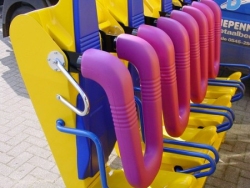 | 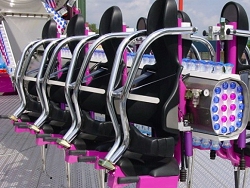 | | Left: The simple overhead restraints found on Afterburners and Move Its Right: The lightweight, minimal restraints on Tango. Images: KMG | | CK: You seem to use different restraint designs according to the ride. Is this to provide most comfortable support according to the ride's movements, or is it because of other considerations? KMG: "We always try to innovate and come up with something new. We did this with the knife locking system on the Tango rides. "The type of restraint always depends on the sort of application. Forces and direction of forces require more or less protection. The restraints we use on Experience and Afterburner rides have been proven to be a very reliable and secure way of restraining riders in their seats." CK: Dutch showman Kroon seems to receive many prototype rides from KMG such as Move It 32, Tango and the new Afterburner XXL. Is this because they're family, or is it for more complex reasons, such as being nearby to deal with any teething problems the ride may face? KMG: "In the first place it's important that we sell our first ride to someone who is on 'our side'. Somebody who thinks with us to improve the ride for further series of the ride, rather than buzzing around what's wrong with the ride. "In our opinion Tonny Kroon is the best person for this job. He is all showman and knows what he wants. He's family and knows exactly what works on a fair and what doesn't." CK: Who is responsible for the lighting packages on KMG's rides? At what stage are these elements designed and presented to the buyer? KMG: "All turbo lights are produced especially for us. We design what lights come on the ride and how a standard package will look like. We don't want to sell a ride without lights even if it makes the ride cheaper. Most of the lighting packages are done by chief of the factory, Albert Kroon". CK: What artist designs and paints the backflash designs? KMG: "There are only a small number of companies good at making backflashes. In my opinion, there is only BB Decorators in Zaandam, The Netherlands, mostly responsible for all Kroon rides. They paint with real paint and their designs always look very refreshing. "Of course there are some other companies like Festidecor from France and Jacek from Germany. Sometimes the customer comes up with a design and has it sprayed by an independent artist." CK: How many people work for KMG, and how many of those are in Research & Development, Design, Fabrication etc? KMG: There are about 15 people working permanently for KMG. There are 5 people on R&D, but since it's a small company we are not working 100% on R&D. "There are two engineers working permanently on drawings, while the other three mostly are involved in the mechanical and electrical design, project management and solving service calls. The other 10 are involved in assembling the rides in the factory. "Of course it does take many more people to build a ride. We only assemble the rides, but with sub-contractors an additional 30 people are busy with welding and manufacturing all the parts for us. CK: How long does it take this workforce to complete an average-sized ride? KMG: "We only design the ride by producing the drawings and controlling the complete project. After the drawings are complete, it will take about three months before we see the parts at the factory. "After then, we need about 3 to 4 weeks to build the ride together. So from beginning to a completely running ride will take about 4 months, of which we will only see 4 weeks. CK: KMG's Move It 32 debuted just a few weeks after Soriani & Moser's Top Star Tour - do you think this is why only one Move It 32 has been sold, or do you think it is just down to showmen preferring the smaller version of the ride? KMG: "To be honest, I think our ride is too expensive for most showmen. The ride is very easy to set up (4 hours) for a three-trailer ride, but this effort (about 50 hydraulic cylinders) has a price. Many showmen preferred the much cheaper and easier [Tivoli] Spin Out ride. CK: Many 'KMG' Move Its were manufactured by Tivoli. Was this down to demand, or were there other reasons? | 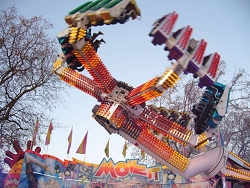
| | The Move It 24 was so popular that many had to be manufactured by British company, Tivoli Enterprises | KMG: "In that time KMG could not answer the demand of rides requested by the US and UK. KMG in those years couldn't afford so many workers to complete all the rides, so the manufacturing was outsourced." CK: How long has KMG been working on the new Afterburner XXL, and how does this compare to other rides? KMG: "Normally it takes about one complete year to finish a ride from idea to finish, but this ride took a year and a half to complete. The building up especially required some attention. We even tested this system before we went any further in the progress to finish the ride." CK: What were the biggest challenges encountered while you designed and fabricated the XXL? KMG: "Building up the ride. The huge structure erects without a crane. It folds on a special way which has a critical point in it, which requires special design of the trailers, which cannot be seen outside." CK: Do you think the future lies in such enormous rides, or was XXL the obvious direction to take following Afterburner's success? KMG: "I personally do not think there is a future for large rides, but for us it was a sort of goal to succeed in. We just wanted to see if we were able to assemble a structure without the use of an enormous crane that is as height as twice the length of the trailer, which is unique in the fair business. "For us we needed a ride which has been a success to make our plan work. The Afterburner ride is quite simple for us and therefore was the best candidate for our new idea." CK: What rides have KMG designed that have never left the drawing board, and why haven't they? KMG: "There are so many ideas that never made it to the drawing board, and others were near completion on the drawing board. We will of course never reveal these ideas, because they might once become reality." CK: What rides can we expect to see from KMG in the near future? KMG: "To be honest, I don't know. Building a ride and realising an idea is so much dependent on what the market wants and how many potential customers we can 'lure' with the idea. There are no concrete plans for the next year, but I'm sure it will be an easy ride." Labels: Interview
Fright Nights: Behind the scenes - part 3
Saturday, March 10, 2007
Alexys Becerra is the lead actor on The Asylum, having worked on the maze for four years since the days when it was The Freezer. | 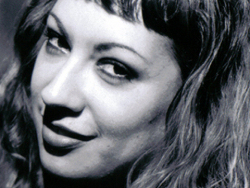
| | Alexys Becerra | The observant among you may recognise Alexys; she starred as Red Haired Betty on WWTP Radio Live over the summer on Stealth-side with a cast of two other voice actors, and has done various roles on The Freezer, 3D Freakshow and The Asylum. Scare acting is just one of many disciplines that Alexys has. "As you get older, you can't be fussy," she says - she has acted on stage, appeared on television, has sung professionally and appears in an industrial band, INERTIA. As well as this, Alexys is also a freelance hair-stylist and professional makeup artist, in terms of both glamour and prosthetic, such as the kind you would find on actors in The Asylum. Married to the keyboard player of Killing Joke, a band who've been featured in NME, Kerrang!, and Rolling Stone, Alexys will be appearing as the lead singer in the Circus of Horrors band as Mistress Serverina from the 2nd of November. | 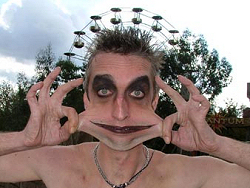
| | Stretch Gary is now one of Alexys' colleagues at the Circus of Horrors | But in October, you're most likely to find Alexys skulking around The Asylum at Thorpe Park, a chaotic scare maze with a cast of actors stalking and terrifying nearly 5000 guests every day. As lead actor, as well as scaring people witless, Alexys is responsible for the cast of 15-30 zombies and freaks, as well as training them and applying their makeup with effects such as cuts, gouges and missing eyeballs. We had the opportunity to talk to a breathless Alexys, having just come out from a gruelling six-hour stint inside possibly one of the most anti-social workplaces in the world. Alexys Becerra's website Coaster Kingdom: Where does a syringe-wielding day-glow redhead zombie come from exactly? Alexys Becerra: "I'm a native Californian, but I'm living in London Docklands." CK: How many years have you been doing Fright Nights for? AB: "I've done four seasons, and five events. I've done the last four Fright Nights in The Asylum and before that, The Freezer, while I came back last summer to do 3D Freakshow which opened briefly before it became Hellgate." CK: How did you get into Fright Nights exactly? AB: "I was in the music industry and decided to take a break. I had just finished presenting my second television show for UKTV and saw an advert in The Stage advertising for 'Freaks and Geeks with attitude' and thought, hey, that sounds like me, so applied." CK: What was the audition like? Did you have any expectations at all? AB: "No expectations as I've never done anything like it in my life. I had no previous experience at all, and was surprised that I got the part, as it wasn't something I ever prepared for seriously. "It was an exciting experience. You have to show lots of disciplines, portray different characters and creatures. It was a lot of fun." CK: What do you do when you're not doing Fright Nights? AB: "I'm in entertainment full time. I play drums for the industrial band INERTIA and will be lead singer in the Circus of Horrors band once Fright Nights finishes, playing Mistress Severina. The advert said something like 'sexy rock witch' which is me all over, but I was apparently up against something like 300 other applicants, so I'm so happy that I got the role. "I'll be working with Dr. Haze, which is beyond my wildest dreams. He's like the nicest person in the world, it's such a privilege" CK: How does Fright Nights compare to other jobs that you've done? AB: "It's unlike anything I've ever done. It's intense and physically draining. It's mentally draining too I suppose, especially dealing with some of the people that come through the maze" CK: So, you're team captain? AB: "Yeah, I was really flattered when they asked me. I'm the first team captain they've had and I'm responsible for everyone in the maze. There's about three regular actors in the maze, and 15 who have returned from previous years, so yeah, there was some tough competition, but I'm glad I got the job." CK: What's the best thing about working at Fright Nights? AB: "Getting dressed up, getting the chance to play someone who's mad and dead, creating magic and fear at the same time. It's a great feeling when you can do that." CK: And the worst thing? AB: "Chavs. Without a doubt." CK: It's funny that they queue up 45 minutes when they just don't want to understand what it's all about, isn't it? AB: "Yeah, I can't understand it. They ruin it for everyone, and they ruin it for their friends. 99% of people are fine, they're there just to have a good time, but it's a shame the minority can ruin it." CK: What changes have you noticed as Fright Nights evolves from year to year? AB: "The mazes have improved structurally, and the actors just get better and better every year." CK: Do you ever feel guilty when you genuinely make someone jump to the point of tears? AB: "No, no guilt at all. I get a kick out of making people vomit and wet themselves, it means you're doing a good job." CK: So have you made anyone wet themselves out of fear? AB: "Oh yes, on Freakshow 3D last summer" CK: On Asylum in particular, you have to work in very anti-social conditions with continual strobe lighting and smoke. How do you cope? AB: "It's something you get used to. We have ear protectors, and sure, for the first ten minutes on the first time you get a headache but it's something that you get used to. "It's all worth it though" Labels: Interview
Fright Nights: Behind the scenes - part 2
Saturday, March 10, 2007
Welcome to volume two of the October Halloween special of Magazine. In this issue, we're still behind the scenes as we find out more about the mechanics behind Thorpe Park's Fright Nights event. We speak to Adam Slevin, who is the Entertainments Team Leader, the event producer and the creator of Hellgate. Adam has worked at Thorpe Park since 2002 where he started as a ride operator before becoming a Rides Team Leader. Since then, he has moved across to become the Entertainments Team Leader and has worked for Tussauds Studios on audio projects for both the theme parks and the waxworks. We caught up with Adam to find out more about the work that goes into Fright Nights. Coaster Kingdom: When do the preparations start for Fright Nights every year? Adam Slevin: "To be honest, they never stop! It's pretty much an ongoing process in terms of ideas, planning, recruitment and construction. The initial planning meetings take place around Easter with the real preparation work starting in June. | 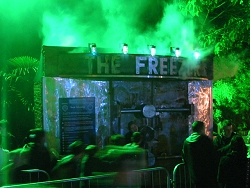
| | Freezer has now become The Asylum | "We then go into production at the end of August, which leads to the hardest seven weeks in the year for our department. We cast the actors for the attractions in September and rehearse just prior to the event in October. CK: What are the biggest challenges you face with Fright Nights? AS: "Delivering the event year on year, and improving it each year is a huge challenge, especially as each year we are catering for more guests. It's also a challenge for a relatively small team keeping so many plates spinning in the air at the same time! CK: Is the event getting easier to organise now it is becoming more established, or do you face new challenges every year as it becomes more popular? AS: "It is easier in some ways because we take away key learnings each year, this year we feel very confident about the delivery of the event and the quality of our attractions. "On the flip side Fright Nights is such a popular event it's always a challenge to live up to peoples' expectations year on year. We improve our established attractions every year and, in the case of this year developed a new one. For 2006 we have developed a fantastic new interactive maze, Se7en, which is based on the seven deadly sins and compliments Hellgate and The Asylum." CK: In total, how many people are involved with Fright Nights, and what are their roles? AS: "There are three of us that make up the core Fright Nights' team from the very start... Kathy Bagshaw - Head of Theme Park Entertainment - Project Manager "Kathy is Project Manager for the event and she keeps an eye on the event budget and provides production schedules as well as leading Fright Nights meetings. Laura Sinclair - Theme Park Entertainment Manager - Project Champion & Event Producer "Laura is based at Thorpe Park as Entertainment Manager and takes a lead with overseeing the installation of attractions, liaising with other departments and managing daily production schedules. Adam Slevin - Theme Park Entertainment Team Leader - Hellgate Designer and Event Producer "I am also based at Thorpe Park and together with Kathy and Laura we deliver the Fright Nights event and the inspiration behind our attractions. I also take a lead with the design and installation of Hellgate. I also have the privilege of delivering the audio for the Fright Nights specific attractions as well as sound across the whole park. "We then also employ two Artistic Directors who deal with all the actors' direction in the attractions. We work closely with the directors to create a sense of style and character for the attractions. They then go on to lead rehearsals with the cast where they spend time developing team spirit and characterisation. "Our Production Assistants, Mark Swain and Lisa Rogers, have the unenviable task of assisting us in the production of Hellgate along with recruitment and administration." CK: The mazes were originally set up by the Sudden Impact! Entertainment Company - why have Thorpe Park since gone it alone, and did you make any changes? If so, why? AS: "Initially the idea of a “scare maze” was new to Thorpe and something we hadn't done before, so we went to Sudden Impact! to install and direct two mazes for us which were The Freezer and the 3D Freak Show. "The following year having the actual mazes already set up and the experience of running them we decided to facilitate their direction and operation in house. Minor alterations were made to the attraction, in particular The Freezer where the maze was changed to a linear maze meaning there was a single route through the attraction. "Previous to this, dead ends meant some groups would take twice as long to get through the attraction, which led to longer queuing times. "By having a linear maze it allows us to control the flow of Guests through the attraction. Some minor operational changes were made to both attractions and we also employed the direction skills of Ollie Frith for both attractions who in previous years had directed street theatre at Thorpe Park." CK: Why did you replace 3D Freakshow with Hellgate? Was it an easy decision to make, and did you have any qualms about removing the 3D element? AS: "We wanted to alter our offering for Fright Nights 2005 because guest feedback suggested the 3D Freakshow was being overshadowed by The Freezer. "We started looking at various new themes for the maze, which included a twisted circus, a demented world of toys and a haunted house (which later became Hellgate). We felt a haunted house theme would work well so I spent time developing some ideas for the attraction which became 'Hellgate'. "Removing the 3D element from the attraction was sad as the artwork was fantastic and part of an established attraction. Once we had a vision for Hellgate though it became a lot easier to say goodbye to an old friend! It can be quite hard not to get attached to things, I am sure I would shed tears if we decided to replace Hellgate!" CK: Why did Freezer get renamed to Asylum in 2005? AS: "We felt the attraction name did not truly reflect the direction we had taken with the maze, which was more akin to a lunatic asylum. We felt as a name, The Asylum, clearly summed up the feel of the attraction and was memorable. "We also reversed the maze so that the exit became the entrance and vice versa which meant we could use the existing staging to develop a fantastic new entrance set based on a 1960's municipal building. "Some other alterations included the removal of the Tesla Coil which was replaced by a Hannibal-style cell and alterations to the layout of the attraction. | 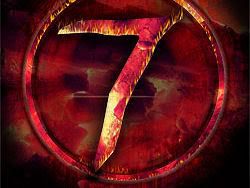
| | Se7en joins The Asylum and Hellgate | CK: A film, False Sense of Security, was added to last years' line up, but spent much of the event closed due to technical difficulties - is this why the show hasn't returned this year? AS: "It was unfortunate but the bad weather and forces of nature were against us last year and meant we did not get to show the film as many times as we would have liked. "Because of the unpredictable British weather, we have replaced the outdoor film in The Arena in favour of our third maze; Se7en." CK: What happens to the mazes during the summer months? Do they stay in-situe or is the space used for something else? AS: "Hellgate and The Asylum pretty much stay as they are all year. We remove some of the external bits of the maze around the queue areas and store them away until the following year. The Asylum area is used during the main season for costume character shows and events on the stage so the maze is used to store different bits and pieces. "Our new maze, Se7en, will be removed at the end of the run to go into storage off site." CK: Why exactly do the mazes open in the early evening as opposed to staying open throughout the day? Wouldn't this help with easing the long queues in the evening? AS: "The year we tried opening the mazes earlier we struggled to get people in them and we were still greeted with the same long queues in the evening. It seems to be very much favoured by guests as an evening experience because the darkness adds to the atmosphere. By opening early evening it also gives us the time during the day to address technical set-up and repair issues in the mazes prior to them opening." CK: Without the limitations of budgets and practicalities, how would you like Fright Nights to evolve? | 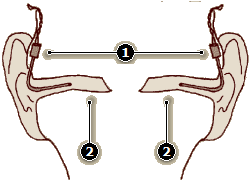
| Binaural sound recording
1. Microphones
2. Ear canals
To record true binaural sound, microphones must be placed in the ears of a human with special microphones, or a special manikin head with headphones is used. | AS: "Now there is a question! I would love to really push our existing attractions to their limits and develop a couple of new mazes. I would probably go with an alien/silo type theme for one and perhaps situate it outdoors and a total darkness theme for another where every sense bar sight is exploited. "I would also like to work on a binaural audio film experience. Binaural audio is a recording technique which when played back through headphones creates an unbelievably realistic 3D sound sensation. Would be great to use a mix of film, audio, special FX and acting. It would also be really nice to create some hybrid experiences using the rides such as No Way Out and Loggers Leap." CK: Taking into account the day-to-day limitations that you face, realistically, what direction do you see the event going in the future? AS: "Fright Nights is Thorpe Park's most popular event and has gone from strength to strength over the years. So much so that we have extended the period we are open to two and a half weeks this year, opening on Friday 13th October. "As with some American parks we may decide to open the event earlier and have a whole month of Fright Nights. With new areas, attractions and a hotel on the near horizon it is very realistic to believe the event will continue to grow and increase in popularity." CK: Alton Towers were planning to charge for Terror of the Towers - has charging for Fright Nights ever been a consideration for Thorpe Park, and if so, with the amount of extra attractions, would that be a single charge for all the Fright Nights attractions? AS: "At the moment there are not talks or plans for charging for the attractions. The only cost one could incur if they want to beat the queues is to purchase a Fastrack ticket for the mazes." | 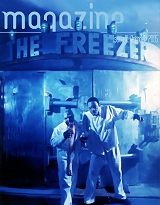
| | Related: Coaster Kingdom's vision for Fright Nights | CK: If Fright Nights becomes much larger, do you think that with the popularity of nighttime opening in October that Fright Nights could ever become a separately ticketed event like Halloween Horror Nights (Universal) or Halloween Haunt (Knotts)? In a perfect world, is this something you'd like to see? AS: "I think the next few years, and especially the development of the hotel, will ultimately be the deciding factor in this." CK: Many people bemoan the fact that Thorpe Park isn't decorated during Fright Nights - we disagree and would rather the park focused on attractions, but would love instead to see a Fright Zone of some kind - would this ever happen? AS: "We have in previous years decorated parts of the park with Halloween displays but as you said, we prefer to focus on the actual attractions, as it is these people come for. I wouldn't rule out having on park theming in the future, but our priority is definitely in the attractions. "We have done a Fright Zone previously, but with the large guest volume we get during Fright Nights and relatively small space we found it restricts the flow of guests around the park and adds to congestion. "That said there will be more general on-park experiences this year with the Circus of Horror actors leaving the theatre and performing their 'freak shows' in cages throughout the park." CK: Are enthusiasts' opinions in any way helpful when it comes to organising events like Fright Nights, or are their opinions unrepresentative and blinkered? AS: "Everyone's opinion is helpful! We design our attractions and tailor our events to our target audience. Enthusiasts often have very strong opinions because they tend to have visited other parks in the USA where Halloween is a very large-scale event and then make direct comparison to our event. "Unfortunately Halloween is not such a large-scale event in England, but we believe this is something that will change year on year, and we hope our event contributes to this change. There is always room for improvement and we are certainly not complaisant, as our new scare maze will show. "We do believe we deliver a good quality event that scores very highly with our target audience and we will always strive to achieve this." CK: How much of a problem is anti-social behaviour at Fright Nights? What has the park done to deal with them aside the obvious security presence? AS: "We are fortunate that these situations are few and far between. However, each year we look back at the previous event and look to improve the security so we can ensure everyone's safety and enjoyment. "We have a strong security team and also we have security based at each attraction who can quickly react to any situation. Our actors and hosts are also trained to handle guest aggression and know the best way to diffuse a situation." CK: Have you had any ideas for Fright Nights that haven't made it to fruition? What were they? AS: "There have been a few such as “The Alley of Death” which was an idea presented where guests would walk down a long path shrouded by trees using pneumatic scare FX and actors positioned in the darkness. "We also looked at having Circus of Horrors performing in The Arena and enclosing the park entrance bridge into a tunnel leading into Port Atlantis. There are ideas flowing constantly and we are always looking into new experiences to improve our offer." CK: What comes first - keeping the queue moving, or presenting a quality show? How do you keep that balance? AS: "Quality of show is key, if people have been queuing a long time it is only right we give them an experience second to none. "We carefully balance the number of people in each group, which is set at eight and a maximum ever of ten and also the spacing between groups in the attraction, which averages 40 seconds. If you make the groups too big you lose the scare factor. We believe we've got a perfect balance of group size and timing intervals to allow for the right balance of show versus throughputs. "Both Hellgate and Se7en will use a triggered cue for sending in the next group this season as opposed to a timed one which should mean Guests are kept a lot more separate and allow us to more efficiently reduce queue times." CK: What is your role in Fright Nights, and how does it change from when you're preparing for the event to during the event itself? AS: "During Fright Nights I am a line manager for a number of the hosts and actors and also, with Laura, take charge of the day to day running of the attractions. We also act as department duty manager in rotation. In the run up to Fright Nights my time is split between recruitment of actors and hosts and physical hands on work in the attractions." CK: What is the best thing about working in Entertainments? AS: "The variation of the job, every day is different and every day brings new challenges. We are constantly working on new projects such as Fright Nights and Be Discovered and it's absolutely fantastic to have so much input in these events. I also work with a fantastic team who make it an absolute joy to come into work every day." CK: What are some of the funniest things that have happened to you during Fright Nights? AS: "I remember walking through The Asylum watching other Guests and then turning too early and walking head first into a wall. I tried to play that one down!" CK: So, it's the last day of the event, the final group have gone through the mazes and the park has closed. How do you celebrate? AS: "We usually have a Halloween party afterwards accompanied by a few beverages into the wee hours of the morning!" CK: How many people work in the Entertainments department and are there more hands on deck for peak times such as Fright Nights? AS: "There are usually three of us that run the department, then up to 30 Hosts and 50 actors for Fright Nights." CK: Other than Fright Nights, what other responsibilities does the Entertainments department have? AS: "We are responsible for our character shows (Top Rockers), summer activities for kids, special events and our stunt show. We also look after park wide sound and provide costume characters for meet and greets on park." CK: How much time in the year is dedicated to Fright Nights in proportion to everything else? AS: "We tend to spread our time equally across our projects. For example as soon as the Fright Nights run comes to an end we will immediately focus on our Easter entertainment and commence auditions for our character shows. From there we work on our summer entertainment and then progress on to Fright Nights again. There are always other things that pop up in between such as ride soundtracks and special events so it's never dull!" Labels: Interview
|